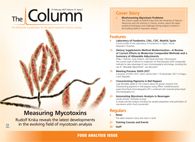Deconstructing Durian Odour
Few fruits are as notorious as the Durian fruit. Native to Southeast Asia but fast becoming available around the globe, these fruits hold the unsavoury title of “the world’s smelliest fruit”. The compounds responsible for such a complex and at times difficult to stomach aroma have intrigued scientists for decades, but until recently the data relating to those chemicals was inconsistent.
Photo Credit: taveesak srisomthavil/Shutterstock.com

Few fruits are as notorious as the Durian fruit. Native to Southeast Asia but fast becoming available around the globe, these fruits hold the unsavoury title of “the world’s smelliest fruit”. The compounds responsible for such a complex and at times difficult to stomach aroma have intrigued scientists for decades, but until recently the data relating to those chemicals was inconsistent.
To address these inconsistencies, researchers from Deutsche Forschungsanstalt für Lebensmittelchemie (German Research Center for Food Chemistry), in Freising, Germany, investigated the fruit using gas chromatography–olfactometry (GC–O), aroma extract dilution analysis (AEDA), and stable isotope dilution assays, to establish the key compounds responsible for the durian fruit odour (1,2).
Nineteen compounds had their odour activity values (OAVs) quantified from the pulp of durians. Three compounds emerged as the most prevalent: ethyl (2S)-2-methylbutanoate (OAV 1700000), which is described as having a fruity smell, ethanethiol (OAV 480000), described as smelling like rotten onion, and 1-(ethylsulfanyl)ethane-1-thiol (OAV 250000), which smells like roasted onion.
“Odour activity values greater than 100,000 are rarely found for food odorants,” explained Martin Steinhaus, lead author of the study. “In a recent meta-analysis on odour-active compounds in food, we found that only 17 OAVs in that range have ever been reported (3).”
“In Haden mangoes, for example, the most potent odour-active compound was identified as fruity smelling ethyl 2-methylbutanoate and exhibited an OAV of 2100 (4),” said Steinhaus. “In durian, the same compound showed an OAV of 1,700,000!”
In addition to investigating the compounds responsible for durians intense aroma, the study also performed omission tests that revealed-surprisingly-only two key compounds (ethyl [2S]-2-methylbutanoate and 1-[ethylsulfanyl]ethane-1-thiol) would be sufficient to evoke the characteristic smell of durian pulp.
The two compounds are described as having aromas of “roasted onion” and “fruity” within the paper, which can be quite misleading. The key insists Martin is the concentration. The roasted onion smell becomes “rather offensive” as the concentration increases, resembling that of ethanethiol or as described in the paper “rotten onion”.
The varieties of durian present further investigative challenges. This study focuses solely on the Monthong variety; some varieties of durian are considered to have an even stronger smell. This is a challenge that Martin and his colleagues are considering for future projects. - L.B.
References
- J.X. Li, P. Schieberle, and M. Steinhaus, J. Agric. Food Chem.60, 11253–11262 (2012).
- J.X. Li, P. Schieberle, and M. Steinhaus, J. Agric. Food Chem.65, 639–647 (2017).
- A. Dunkel et al., Angew. Chem. Int. Ed.53, 7124–7143 (2014).
- J.P. Munafo Jr., J. Didzbalis, R.J. Schnell, and M. Steinhaus, J. Agric. Food Chem.64, 4312−4318 (2016).

Polysorbate Quantification and Degradation Analysis via LC and Charged Aerosol Detection
April 9th 2025Scientists from ThermoFisher Scientific published a review article in the Journal of Chromatography A that provided an overview of HPLC analysis using charged aerosol detection can help with polysorbate quantification.
Analyzing Vitamin K1 Levels in Vegetables Eaten by Warfarin Patients Using HPLC UV–vis
April 9th 2025Research conducted by the Universitas Padjadjaran (Sumedang, Indonesia) focused on the measurement of vitamin K1 in various vegetables (specifically lettuce, cabbage, napa cabbage, and spinach) that were ingested by patients using warfarin. High performance liquid chromatography (HPLC) equipped with an ultraviolet detector set at 245 nm was used as the analytical technique.
Removing Double-Stranded RNA Impurities Using Chromatography
April 8th 2025Researchers from Agency for Science, Technology and Research in Singapore recently published a review article exploring how chromatography can be used to remove double-stranded RNA impurities during mRNA therapeutics production.













